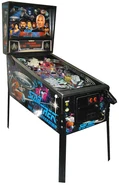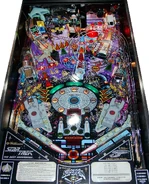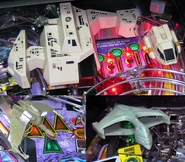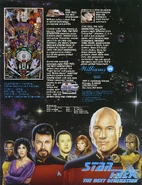m (lk fix) |
|||
| (11 intermediate revisions by 8 users not shown) | |||
| Line 1: | Line 1: | ||
| − | {{ |
+ | {{real world}} |
[[File:Williams Star Trek TNG pinball backglass.jpg|thumb|Backglass from the ''Star Trek: TNG'' pinball machine]] |
[[File:Williams Star Trek TNG pinball backglass.jpg|thumb|Backglass from the ''Star Trek: TNG'' pinball machine]] |
||
| − | The '''''Star Trek: The Next Generation'' pinball machine''' was a pinball game created by [[WMS Industries|Williams Electronic Games]] in 1993. A wide-body machine, the game prominently featured the {{USS|Enterprise|NCC-1701-D|-D}} as well as original recordings from the eight main cast members of the [[TNG]] series. |
+ | The '''''Star Trek: The Next Generation'' pinball machine''' was a [[Star Trek Pinball|pinball game]] created by [[WMS Industries|Williams Electronic Games]] in 1993. A wide-body machine, the game prominently featured the {{USS|Enterprise|NCC-1701-D|-D}} as well as original recordings from the eight main cast members of the [[TNG]] series. |
== Gameplay == |
== Gameplay == |
||
| Line 10: | Line 10: | ||
The mechanism that allowed the machine to feed balls to the launchers and other locations, developed for this table, was patented by Williams in the US as [http://www.google.com/patents/US5350174 #5,350,174], granted on 27 September 1994. The launchers themselves were the subject of an earlier patent, [http://www.google.com/patents/US5186462 #5,186,462]. |
The mechanism that allowed the machine to feed balls to the launchers and other locations, developed for this table, was patented by Williams in the US as [http://www.google.com/patents/US5350174 #5,350,174], granted on 27 September 1994. The launchers themselves were the subject of an earlier patent, [http://www.google.com/patents/US5186462 #5,186,462]. |
||
| − | Ball locking was a feature of the game, as with most pinball machines. As additional balls were locked, a storyline involving the large [[Borg |
+ | Ball locking was a feature of the game, as with most pinball machines. As additional balls were locked, a storyline involving the large [[Borg type 03|Rogue Borg ship]] mounted on the playfield advanced. Once three balls had been locked, the game entered multiball mode. In multiball mode, the left launcher is used to hit the Neutral Zone drop and award jackpot values. Once the drop is hit three times, or after the first miss, the three locked balls are returned to the playfield. The player must destroy the Borg ship by hitting the jackpot targets (the Start Mission drop and the Delta Quadrant ramp), before the ''Enterprise''{{'}}s shields are drained, and the Start Mission drop stops awarding jackpots. The spinner is used to "regenerate" the shields and reactivate the jackpot. |
=== Missions === |
=== Missions === |
||
Missions are displayed on the playfield around the periphery of the ''Enterprise'' saucer section. Only one is lit at a time - hitting the Q target bumper changes which mission is lit, and the mission can be started by hitting the Start Mission drop. A mission can also be selected by hitting the Command Decision drop. Completing mission objectives earns one of four Artifacts: Singing Stone, Isolinear Chip, Duranium Sphere, and Dilithium Crystal. Each Artifact can be collected more than once. |
Missions are displayed on the playfield around the periphery of the ''Enterprise'' saucer section. Only one is lit at a time - hitting the Q target bumper changes which mission is lit, and the mission can be started by hitting the Start Mission drop. A mission can also be selected by hitting the Command Decision drop. Completing mission objectives earns one of four Artifacts: Singing Stone, Isolinear Chip, Duranium Sphere, and Dilithium Crystal. Each Artifact can be collected more than once. |
||
;Time Rift |
;Time Rift |
||
| + | :All targets are lit where the player can earn between ten and 25 million points per hit. The two time rift markers are also lit which will add time and increase the score value. The player can add up to a maximum of 30 seconds to the timer from the two time rift markers. Hitting five time rift targets earns you an Artifact. |
||
| + | |||
;Worm Hole |
;Worm Hole |
||
| + | :The player must hit the Wormhole target which is located on the 'Delta Quadrant' ramp. Hitting the 'Beta Quadrant' ramp adds ten million points to the reward and the spinner adds one million per spin. Hitting the ramp awards an Artifact and the warm hole award. |
||
| + | |||
;Search The Galaxy |
;Search The Galaxy |
||
:The player must hit the 'Quadrant' ramps in order to complete the mission. Hitting any three ramps earns an Artifact. Hitting all three and the Neutral Zone drop, in the order given by Riker, earns a second Artifact. |
:The player must hit the 'Quadrant' ramps in order to complete the mission. Hitting any three ramps earns an Artifact. Hitting all three and the Neutral Zone drop, in the order given by Riker, earns a second Artifact. |
||
;Battle Simulation |
;Battle Simulation |
||
| − | :The player must use the launchers to hit either the Neutral Zone or the Warp Speed drops. A 20-second timer is used to With the first miss, the ball returns to normal play, but the drops may still be hit to continue the mission. Each successful hit advances the simulation to the next level, with level six being the highest. Completing Level |
+ | :The player must use the launchers to hit either the Neutral Zone or the Warp Speed drops. A 20-second timer is used to With the first miss, the ball returns to normal play, but the drops may still be hit to continue the mission. Each successful hit advances the simulation to the next level, with level six being the highest. The player can only attempt to complete level six if he or she is able to complete the shots without missing. Completing Level Five earns an Artifact whereas completing Level Six earns an Extra Ball. |
;Q's Challenge |
;Q's Challenge |
||
| − | :The player must hit the lit targets. |
+ | :The player must hit the lit targets. Each target hit earns a cumulative award of ten million points, up to a maximum of 100 million points per hit. Hitting the Q target lights another target. Each lit target will time-out after fifteen seconds. The mission ends when all targets have timed-out. Hitting five targets earns an Artifact. |
;Rescue |
;Rescue |
||
| + | :There are 50 Starfleet personnel that must be rescued by the player either by transporter or shuttlecraft. Hitting the spinner, targets, or the Borg jackpot bumpers adds personnel to the shuttle. The 'Alpha Quadrant' and 'Beta Quadrant' ramps launch the shuttle with whatever personnel is on board. An Artifact is awarded when 25 personnel have boarded the shuttle, transported out, or a combination of the two. When the remaining personnel are ready to be extracted, the computer will alert the player. When all 50 personnel are rescued, a second Artifact will be awarded. |
||
| + | |||
;Asteroid Threat |
;Asteroid Threat |
||
| + | The player must first destroy the incoming asteroid by shooting the centre pocket. At the start the award for this mission starts at 20 million which decreases every second the asteroid is in tact down to a minimum of five million. When the player successfully destroys the first asteroid, the point value stays at whatever the player has locked and all remaining targets are lit. Destroying five asteroids (including the first one) earns an Artifact where destroying all the asteroids scores 50 million points, regardless of the point value that was captured from the beginning; and a second Artifact. |
||
Once all seven missions have been completed, an additional mission commences: |
Once all seven missions have been completed, an additional mission commences: |
||
;The Final Frontier |
;The Final Frontier |
||
| − | :A six-ball multiball mode (four from the multiball holders, two in the launchers), the mission begins with awarding bonuses for each Artifact earned, with |
+ | :A six-ball multiball mode (four from the multiball holders, two in the launchers), the mission begins with awarding bonuses for each Artifact earned, with one billion points earned for each complete sets of four. Shots made during the mode are awarded points based on the number of Artifacts earned, up to 250 million per shot. This is considered the game's "Wizard Mode". |
<gallery> |
<gallery> |
||
| Line 36: | Line 43: | ||
File:Williams Star Trek TNG pinball machine.jpg|''Star Trek: TNG'' pinball cabinet |
File:Williams Star Trek TNG pinball machine.jpg|''Star Trek: TNG'' pinball cabinet |
||
File:Williams Star Trek TNG pinball playfield.jpg|''Star Trek: TNG'' pinball playfield |
File:Williams Star Trek TNG pinball playfield.jpg|''Star Trek: TNG'' pinball playfield |
||
| − | File:Rogue ship pinball.jpg|Close-ups of the [[Borg |
+ | File:Rogue ship pinball.jpg|Close-ups of the [[Borg type 03|Rogue Borg ship]] and other starships |
File:Williams Star Trek TNG pinball ad.jpg|''Star Trek: TNG'' pinball machine promo poster |
File:Williams Star Trek TNG pinball ad.jpg|''Star Trek: TNG'' pinball machine promo poster |
||
</gallery> |
</gallery> |
||
| − | |||
== Virtual reconstruction == |
== Virtual reconstruction == |
||
| − | [[File:Williams TNG pinball machine, virtual reconstruction.jpg|thumb|The virtual reconstruction of the playfield |
+ | [[File:Williams TNG pinball machine, virtual reconstruction.jpg|thumb|The virtual reconstruction of the playfield]] |
| − | On {{d|1|June|2012}}, [[FarSight Studios]] announced that, as part of their {{w|Kickstarter}} project to |
+ | On {{d|1|June|2012}}, [[FarSight Studios]] announced that, as part of their {{w|Kickstarter}} project to digitize Williams' ''The Twilight Zone'' machine for their Pinball Arcade app, they would seek funds to purchase the license to the ''Next Generation'' table as a "stretch goal". [http://www.kickstarter.com/projects/1067367405/pinball-arcade-the-twilight-zone/posts/238560] Although the target donation amount was not achieved in the allotted time, the response to the announcement resulted in FarSight launching a second Kickstarter on {{d|17|August|2012}}, solely for the ''Next Generation'' table. US$45,000 was the initial target, to cover the remaining fees required. At the end of the project, US$52,137 had been donated. [http://www.kickstarter.com/projects/1067367405/pinball-arcade-star-trek-the-next-generation] |
The virtual reconstruction of the table was released to iOS, Android, and Mac OSX on {{d|21|December|2012}}. |
The virtual reconstruction of the table was released to iOS, Android, and Mac OSX on {{d|21|December|2012}}. |
||
| Line 57: | Line 63: | ||
== External links == |
== External links == |
||
*[http://www.ipdb.org/machine.cgi?id=2357 Star Trek: The Next Generation] at [http://www.ipdb.org The Internet Pinball Database] |
*[http://www.ipdb.org/machine.cgi?id=2357 Star Trek: The Next Generation] at [http://www.ipdb.org The Internet Pinball Database] |
||
| − | * |
+ | *{{YouTube|type=v|UFvAS8ltIXU|Promotional video|external}} |
| − | [[Category: |
+ | [[Category:Electronic games]] |
Revision as of 21:40, 14 February 2019
(written from a Production point of view)
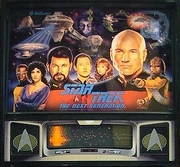
Backglass from the Star Trek: TNG pinball machine
The Star Trek: The Next Generation pinball machine was a pinball game created by Williams Electronic Games in 1993. A wide-body machine, the game prominently featured the USS Enterprise-D as well as original recordings from the eight main cast members of the TNG series.
Gameplay
Although the general aim of the game was to score as many points as possible, the machine featured a complex array of ramps, bumpers, and drops which allowed the player to complete a series of missions provided by the game.
One of the unique features of the Next Generation machine was the presence of two ball launchers mounted on either side of the playfield. These allowed an alternative method of feeding the ball into the playfield, and were used in some of the missions.
The mechanism that allowed the machine to feed balls to the launchers and other locations, developed for this table, was patented by Williams in the US as #5,350,174, granted on 27 September 1994. The launchers themselves were the subject of an earlier patent, #5,186,462.
Ball locking was a feature of the game, as with most pinball machines. As additional balls were locked, a storyline involving the large Rogue Borg ship mounted on the playfield advanced. Once three balls had been locked, the game entered multiball mode. In multiball mode, the left launcher is used to hit the Neutral Zone drop and award jackpot values. Once the drop is hit three times, or after the first miss, the three locked balls are returned to the playfield. The player must destroy the Borg ship by hitting the jackpot targets (the Start Mission drop and the Delta Quadrant ramp), before the Enterprise's shields are drained, and the Start Mission drop stops awarding jackpots. The spinner is used to "regenerate" the shields and reactivate the jackpot.
Missions
Missions are displayed on the playfield around the periphery of the Enterprise saucer section. Only one is lit at a time - hitting the Q target bumper changes which mission is lit, and the mission can be started by hitting the Start Mission drop. A mission can also be selected by hitting the Command Decision drop. Completing mission objectives earns one of four Artifacts: Singing Stone, Isolinear Chip, Duranium Sphere, and Dilithium Crystal. Each Artifact can be collected more than once.
- Time Rift
- All targets are lit where the player can earn between ten and 25 million points per hit. The two time rift markers are also lit which will add time and increase the score value. The player can add up to a maximum of 30 seconds to the timer from the two time rift markers. Hitting five time rift targets earns you an Artifact.
- Worm Hole
- The player must hit the Wormhole target which is located on the 'Delta Quadrant' ramp. Hitting the 'Beta Quadrant' ramp adds ten million points to the reward and the spinner adds one million per spin. Hitting the ramp awards an Artifact and the warm hole award.
- Search The Galaxy
- The player must hit the 'Quadrant' ramps in order to complete the mission. Hitting any three ramps earns an Artifact. Hitting all three and the Neutral Zone drop, in the order given by Riker, earns a second Artifact.
- Battle Simulation
- The player must use the launchers to hit either the Neutral Zone or the Warp Speed drops. A 20-second timer is used to With the first miss, the ball returns to normal play, but the drops may still be hit to continue the mission. Each successful hit advances the simulation to the next level, with level six being the highest. The player can only attempt to complete level six if he or she is able to complete the shots without missing. Completing Level Five earns an Artifact whereas completing Level Six earns an Extra Ball.
- Q's Challenge
- The player must hit the lit targets. Each target hit earns a cumulative award of ten million points, up to a maximum of 100 million points per hit. Hitting the Q target lights another target. Each lit target will time-out after fifteen seconds. The mission ends when all targets have timed-out. Hitting five targets earns an Artifact.
- Rescue
- There are 50 Starfleet personnel that must be rescued by the player either by transporter or shuttlecraft. Hitting the spinner, targets, or the Borg jackpot bumpers adds personnel to the shuttle. The 'Alpha Quadrant' and 'Beta Quadrant' ramps launch the shuttle with whatever personnel is on board. An Artifact is awarded when 25 personnel have boarded the shuttle, transported out, or a combination of the two. When the remaining personnel are ready to be extracted, the computer will alert the player. When all 50 personnel are rescued, a second Artifact will be awarded.
- Asteroid Threat
The player must first destroy the incoming asteroid by shooting the centre pocket. At the start the award for this mission starts at 20 million which decreases every second the asteroid is in tact down to a minimum of five million. When the player successfully destroys the first asteroid, the point value stays at whatever the player has locked and all remaining targets are lit. Destroying five asteroids (including the first one) earns an Artifact where destroying all the asteroids scores 50 million points, regardless of the point value that was captured from the beginning; and a second Artifact.
Once all seven missions have been completed, an additional mission commences:
- The Final Frontier
- A six-ball multiball mode (four from the multiball holders, two in the launchers), the mission begins with awarding bonuses for each Artifact earned, with one billion points earned for each complete sets of four. Shots made during the mode are awarded points based on the number of Artifacts earned, up to 250 million per shot. This is considered the game's "Wizard Mode".
Virtual reconstruction
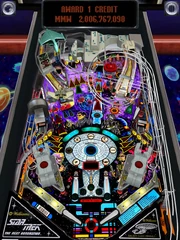
The virtual reconstruction of the playfield
On 1 June 2012, FarSight Studios announced that, as part of their Kickstarter project to digitize Williams' The Twilight Zone machine for their Pinball Arcade app, they would seek funds to purchase the license to the Next Generation table as a "stretch goal". [1] Although the target donation amount was not achieved in the allotted time, the response to the announcement resulted in FarSight launching a second Kickstarter on 17 August 2012, solely for the Next Generation table. US$45,000 was the initial target, to cover the remaining fees required. At the end of the project, US$52,137 had been donated. [2]
The virtual reconstruction of the table was released to iOS, Android, and Mac OSX on 21 December 2012.
Game credits
- Steve Ritchie, Design & Direction
- Dwight Sullivan & Matt Coriale, Software
- Carl Biagi, Mechanical
- Greg Freros, Art & Design
- Dan Forden, Sound & Music
- Scott Slomlany & Eugene Greer, Dot Matrix

